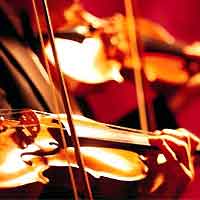The Symphonic Orchestra celebrating its fifty Anniversary
- Submitted by: admin
- Arts and Culture
- culture an traditions
- Culture and Traditions
- Havana
- History
- Music
- national
- personalities
- Society
- Personalities
- 02 / 14 / 2010

The Symphonic Orchestra draws this year the curtains of their main venue, the Theater Auditorium Amadeo Roldan, to celebrate its fiftieth anniversary.
Its great celebration will be in these 12 months, although they have wanted to prepare four special shows to review so much good music put together through the years.
Roberto Chorens, its general director, explains exclusively for Cubasi that the first of these shows took place on Sunday January 31.
“That day the orchestra was directed by maestro Guido Lopez-Gavilan. A total of 16 founders and three institutions closely related with the foundation of the group were granted decorations, like ICAIC, the National Theater, and the National Ballet of Cuba.”
The National Symphonic Orchestra (NSO) has begun an excellent season thus is evidenced in the New Year eve’s concerts of the Italian violinist Francesco Manara and with the Cuban jazz player Ernan Lopez Nussa. Soon the Symphonic will tour in the Island and they will take advantage of the journey to show their wide repertoire.
They will also meet unavoidable international commitments in Latin America and Europe...
We have plenty of plans for the future, and we have many details to remember in these 50 years. Chorens remembers the tiniest of things – regardless his age is not well-matched with the years of the emblematic orchestra -: “the first concert’s programme of the Symphonic in 1960 it was directed by Adagio Gonzales Marquez.
Alejandro Garcia Caturla was chosen, a vanguard composer who had learned from all the black features that appeared in the Cuban music, something very risky for the time, because racial prejudices were overwhelming.
“The truth is that by late 1959 the future musicians of the Symphonic Orchestra were searched and the first scores are started to put together”, he comments.
- What impact had the technical support received by the NSO, of professors coming from the socialist field?
- The orchestra, as in many sides of the Cuban life and society had in the first decades, after 1959, large collaboration from Bulgarian, Romanian, and Russian artists -we have a great influence of the latter.
“It was strong the teaching of the violin, the cello, the viola, and the contrabass. We knew how to take advantage of the presence here of those professionals, as well as the possibility of training musicians in those countries.”
- This is a large group, of 90 musicians. What are the artistic projections they have?
- I have the personal idea that the NSO will reach higher states in the symphonic field. Thus is supported by the foreign guests that every year come to play here. This means that the group can reach a higher level and that’s where we are heading.
In an orchestra of so many young members. We have members who have stayed for two, three and even more than four decades playing with us.
"Most of its members deliver classes in the different music schools of the capital. And the newest receive as practice, the possibility of playing in chamber assembles, created within the Symphonic.”
- How is the program of shows organized by the orchestra in a year?
- The NSO has two seasons: January to July, and September to December. The programs to interpret change every week. The same happens to its director, each one of them assumes the orchestra's potentialities from their own vision.
“It’s important to make people aware that all our members do not play every week. We have different teams prepared, so that we can keep them in shape and take care of them.
“There are instruments that tire the musicians like percussion, trombones, trumpets... that if you lack training, you can lose the skills quickly. Everything aims at taking care of their lives, as it happens with sportsmen, not all attend at the same competition.”
- Is there any special interest of foreign artists to work together with you?
- The orchestra has a huge convocation. And whenever a great musician accepts to come to the Island, our members learn from them. It’s already a matter of appreciation, because then they disclose their experiences in their own countries.
“The Italian Claudio Abbado, Francesco Belli, and Francesco Manara; the Japanese Yoshikazu Fukumura; the French Michel Legrand, and Nathalie Marin, the North American Carmine Coppola, and Bernard Rubenstein, and the Colombian Cecilia Espinosa and Felipe Aguirre, have performed with us among others.
“Important Cuban directors have also distinguished us like the maestro Roberto Valera, Leo Brouwer, Guido Lopez-Gavilan, Jorge Lopez Marin, Zenaida Castro Romeu, Dayana Garcia—who in 2009 started to act as such—, and Enrique Perez Mesa who is the regular director of the Symphonic Orchestra.”
- How does the NSO contribute to the development of this type of music in the country?
- We are constantly helping our peers from Camaguey, Santa Clara, Holguin, Matanzas, and Oriente. What does this help consist of?: in sending our musicians to play there with them.
“We want to establish a project where the members of the groups from the provinces come to the capital and participate in the concerts with us. We have also carried out four encounters of symphonic orchestras, which have contributed greatly to this
line we develop together with the Cuban Institute of Music.”
Source: Cubasi
Comments